Evolution of The Ship Excursion - Part III
By Don Dressel
One item that was not mentioned in last months article one the first day
in Copenhagen was a trip to the National Maritime Museum, where we
had an excellent lecture on the Hjortspring boat, c 350-300 BC. This
rowing boat, found in a bog in Denmark, is one of the earliest
northern European vessels and fills a transitional niche between
boats fabricated from animal skins and proto ships constructed of
wood. Unfortunately, the actual boat was not there but the many
pictures supplied in the special lecture filled the gape.
As indicated in last months article, we now continue our excursion
in Europe with a visit to the Viking Ship Museum at Roskilde. This
museum houses the Skuldelov ships of the 11th century. These are
five Viking age wrecks, deliberately sunk to block passage to
Roskilde Fjord. This rich assemblage of Viking ships
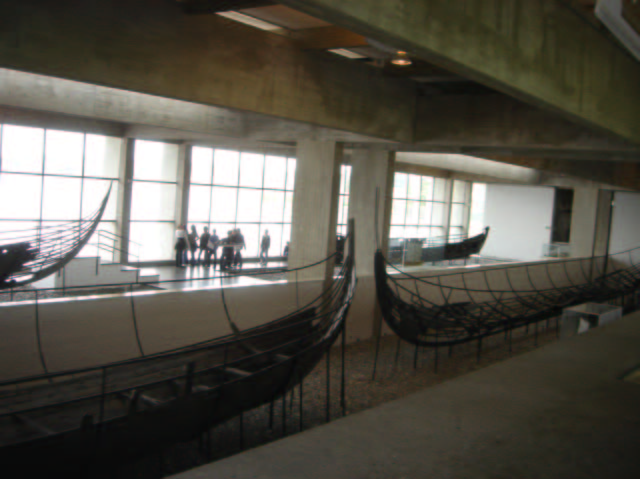 contains two types of long ships used for warfare, knars or merchant
vessels used for long range trade, and coastwise vessels, providing
a cross section of Viking maritime life. Along with the five Viking
vessels, that are partially assembled, there are also very good
models of the vessels and, outside the museum, five replicas of the
real ships that you can actually sail on. This is really a very
large museum complex, and you could spend a full day here. There is
a film to see in the museum’s main building where the five Viking
ships are housed as well as the models. Outside is the “harbor”
which has a lot of ships and boats on display at full scale (real
ships) along with the five rebuilt Viking ships, all of which can be
taken to sea. There is a workshop with all the tools
contains two types of long ships used for warfare, knars or merchant
vessels used for long range trade, and coastwise vessels, providing
a cross section of Viking maritime life. Along with the five Viking
vessels, that are partially assembled, there are also very good
models of the vessels and, outside the museum, five replicas of the
real ships that you can actually sail on. This is really a very
large museum complex, and you could spend a full day here. There is
a film to see in the museum’s main building where the five Viking
ships are housed as well as the models. Outside is the “harbor”
which has a lot of ships and boats on display at full scale (real
ships) along with the five rebuilt Viking ships, all of which can be
taken to sea. There is a workshop with all the tools
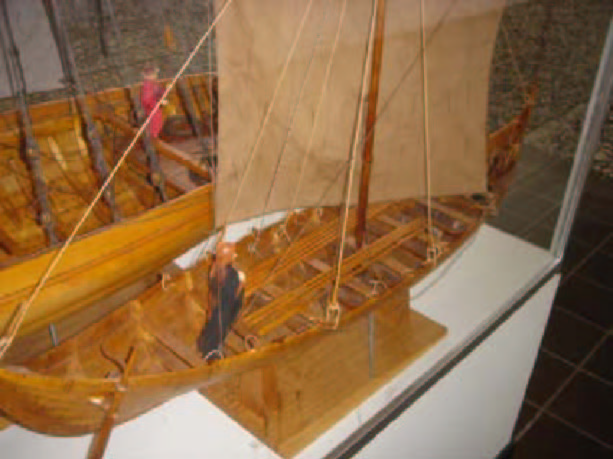 used by the Vikings to make their ships. When I say tools, I really
mean all the different kind of “axes” that were used – no saws,
hammers, etc. The evening was again spent in enjoying the
hospitality of the Danish people. My wife Liz was very taken with
the colors of the buildings in Copenhagen and the beautiful canals
that went throughout the city.
used by the Vikings to make their ships. When I say tools, I really
mean all the different kind of “axes” that were used – no saws,
hammers, etc. The evening was again spent in enjoying the
hospitality of the Danish people. My wife Liz was very taken with
the colors of the buildings in Copenhagen and the beautiful canals
that went throughout the city.
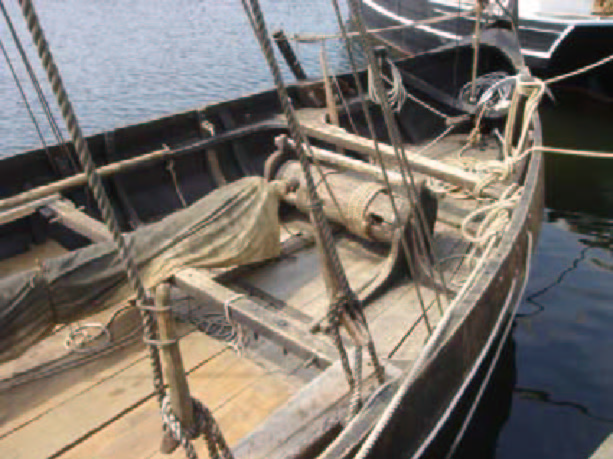 After breakfast in Copenhagen, we departed via coach (a very nice
ride) for Schleswig, Germany. This was the ninth day of the trip, so
we were about half way through the excursion. The countryside that
you pass while traveling is very picturesque. While on these coach
trips, we were privileged to have comprehensive lectures on the
things we had seen and the things we were going to see by Dr.
Ashley, the Executive Director of the
After breakfast in Copenhagen, we departed via coach (a very nice
ride) for Schleswig, Germany. This was the ninth day of the trip, so
we were about half way through the excursion. The countryside that
you pass while traveling is very picturesque. While on these coach
trips, we were privileged to have comprehensive lectures on the
things we had seen and the things we were going to see by Dr.
Ashley, the Executive Director of the
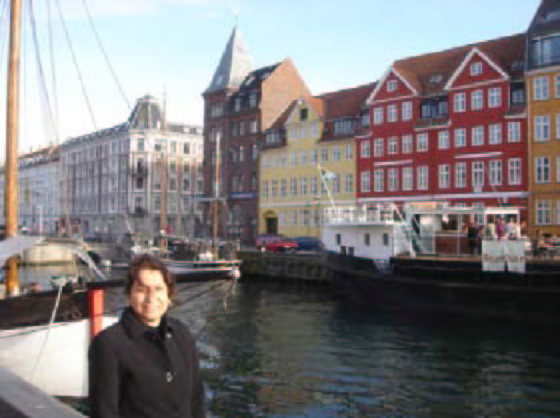 Maritime
Museum of San Diego. We found out later that he is also Captain
Ashley, but more about that when we get to England. In Schleswig we
went to the Schloss Gotorp Museum, which is really a German castle.
There, we saw the Nydam boat, c 310-320 AD, a rowing proto Viking
ship found in a bog on the Jutland Peninsula. This vessel is a
superbly crafted expression of early Dark Age naval power and
possibly exemplifies the kind of vessels that were used to conduct
migrations of Germanic peoples in the time of Beowolf and the
Anglo-Saxon invasions of Britain.
Maritime
Museum of San Diego. We found out later that he is also Captain
Ashley, but more about that when we get to England. In Schleswig we
went to the Schloss Gotorp Museum, which is really a German castle.
There, we saw the Nydam boat, c 310-320 AD, a rowing proto Viking
ship found in a bog on the Jutland Peninsula. This vessel is a
superbly crafted expression of early Dark Age naval power and
possibly exemplifies the kind of vessels that were used to conduct
migrations of Germanic peoples in the time of Beowolf and the
Anglo-Saxon invasions of Britain.
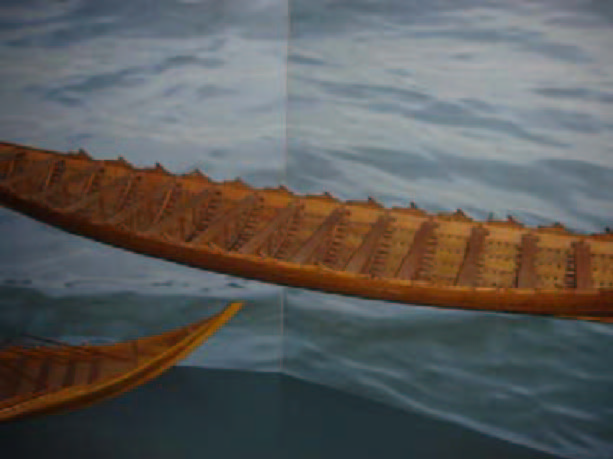 The
Nydam boat was housed in it’s own building next to the castle. The
castle itself was a museum with many, many interesting items to see.
Then, behind the Nydam boat building was a carriage house, which had
a great many different carriages and sleds to see. Again, there was
a lot to see and not enough time available to see everything. The
grounds around the castle were also very beautiful, reminding me of
the Huntington Gardens in San Marino. After the night’s stay at the
Hotel Waldschlosschen (which, by the way, has no problems with
swimming – one person forgot his bathing suit but wanted to go
swimming in the hotel pool. The receptionist said that was no
problem, he/she could just swim in the nude – they have no problem
with that) we departed for Hamburg, Germany.
The
Nydam boat was housed in it’s own building next to the castle. The
castle itself was a museum with many, many interesting items to see.
Then, behind the Nydam boat building was a carriage house, which had
a great many different carriages and sleds to see. Again, there was
a lot to see and not enough time available to see everything. The
grounds around the castle were also very beautiful, reminding me of
the Huntington Gardens in San Marino. After the night’s stay at the
Hotel Waldschlosschen (which, by the way, has no problems with
swimming – one person forgot his bathing suit but wanted to go
swimming in the hotel pool. The receptionist said that was no
problem, he/she could just swim in the nude – they have no problem
with that) we departed for Hamburg, Germany.
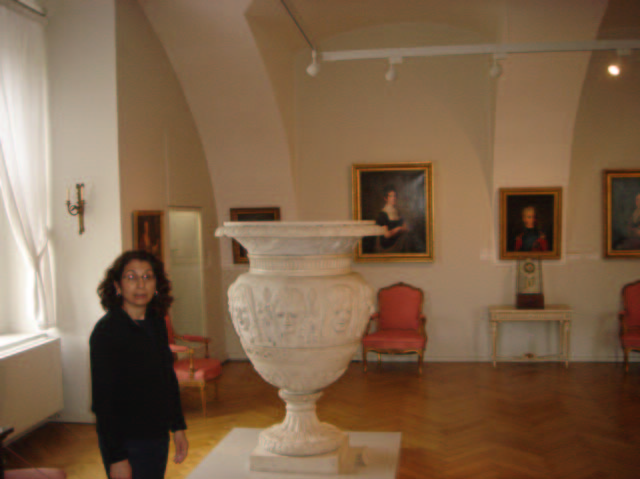
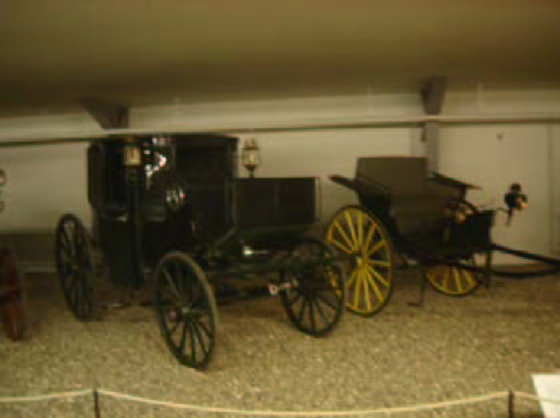 Hamburg
is a vibrant city with world-class shopping. Germany’s second
largest city, it has a magnificent harbor right at its center and
many canals and bridges. We were very lucky in that we got to visit
the Peter Tamm collection at the Institute fur Schiffahrt und
Marinegeschichte. This is currently a private collection that will
shortly (2009) become public at the Hamburg Maritime Museum. There
are over 5,000 paintings, watercolors and graphics from 1570 to
present, 2,000 big ship models, 22,000 smaller ship models, military
uniforms from the German
Hamburg
is a vibrant city with world-class shopping. Germany’s second
largest city, it has a magnificent harbor right at its center and
many canals and bridges. We were very lucky in that we got to visit
the Peter Tamm collection at the Institute fur Schiffahrt und
Marinegeschichte. This is currently a private collection that will
shortly (2009) become public at the Hamburg Maritime Museum. There
are over 5,000 paintings, watercolors and graphics from 1570 to
present, 2,000 big ship models, 22,000 smaller ship models, military
uniforms from the German
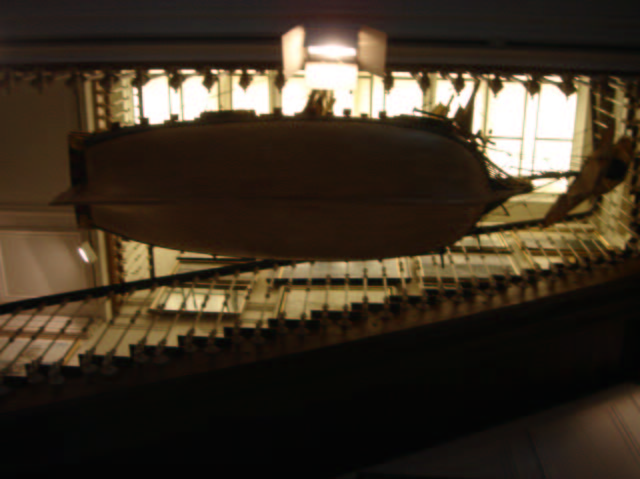 Navy
as well as WWII uniforms from Britain, the US, France, etc. The
picture at the left shows the very large model of the Frederick
Wilhelm mounted from the roof and hanging between the stairs leading
to the third floor as seen from the lower landing . The picture at
the right shows one of the many paintings.
Navy
as well as WWII uniforms from Britain, the US, France, etc. The
picture at the left shows the very large model of the Frederick
Wilhelm mounted from the roof and hanging between the stairs leading
to the third floor as seen from the lower landing . The picture at
the right shows one of the many paintings.
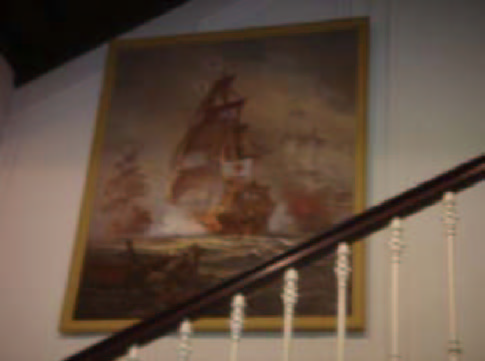 I managed to take these two pictures before we were told we could
not take pictures – was really sorry about that, as there were so
many models and things to take pictures of. OH, WELL – you can’t win
them all. There are two of the currently four existing in the world
ENIGMA machines (Germany’s secret coding machine during WWII),
plates, silverware, and other artifacts from ships, maps, globes,
etc. In short, the collection is awesome. We were lucky to see the
collection (they had a
I managed to take these two pictures before we were told we could
not take pictures – was really sorry about that, as there were so
many models and things to take pictures of. OH, WELL – you can’t win
them all. There are two of the currently four existing in the world
ENIGMA machines (Germany’s secret coding machine during WWII),
plates, silverware, and other artifacts from ships, maps, globes,
etc. In short, the collection is awesome. We were lucky to see the
collection (they had a
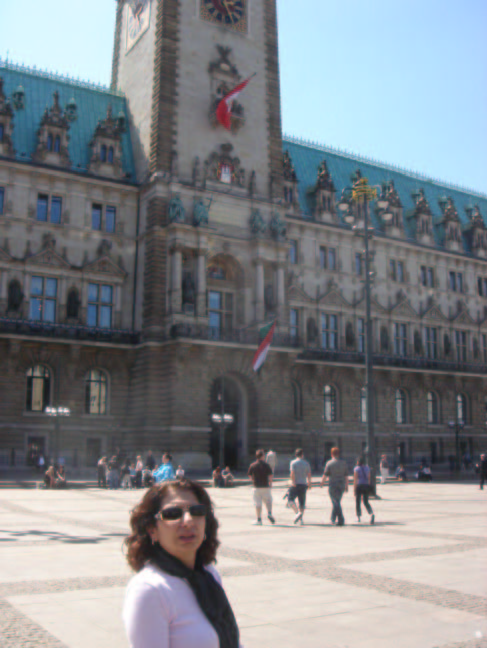 great
model of what the WWII German aircraft carrier would have looked
like if built) all in one place.
great
model of what the WWII German aircraft carrier would have looked
like if built) all in one place.
Thursday, May 24th, after breakfast at the hotel in Hamburg, we went
to the Deutsche Schiffahrt Museum to see the Bremen Cog. Again, more
time would have been great at this Big museum,
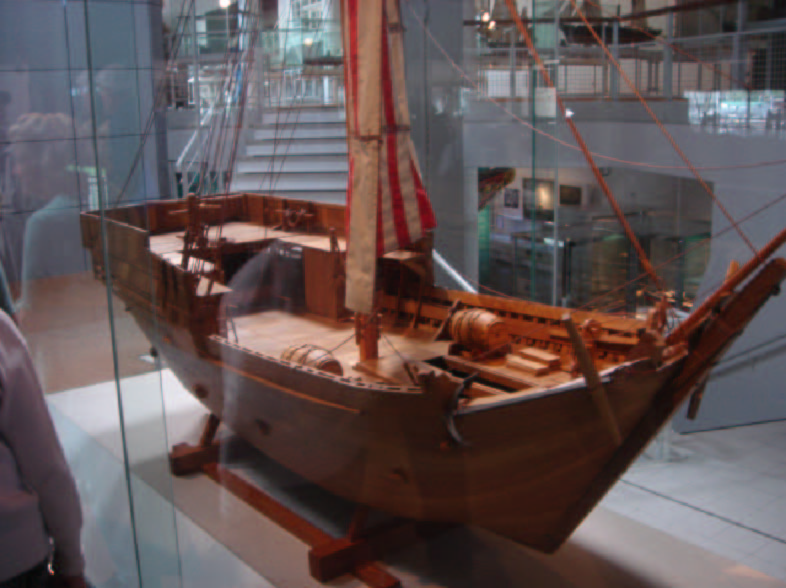 as
there was a lot to see. The Bremen Cog, c. 1380, is a medieval
merchant ship buried accidentally during a flood and recently found,
excavated intact, and replicated in fully working form. This Bremen
Cog is a superb example of the most important ship type of the
Middle Ages in the time of the Hansa League. Displacing and
superseding the much lighter Viking craft, the cog set the
technological stage for the advent of European sea borne empires a
century and a half later.
as
there was a lot to see. The Bremen Cog, c. 1380, is a medieval
merchant ship buried accidentally during a flood and recently found,
excavated intact, and replicated in fully working form. This Bremen
Cog is a superb example of the most important ship type of the
Middle Ages in the time of the Hansa League. Displacing and
superseding the much lighter Viking craft, the cog set the
technological stage for the advent of European sea borne empires a
century and a half later.
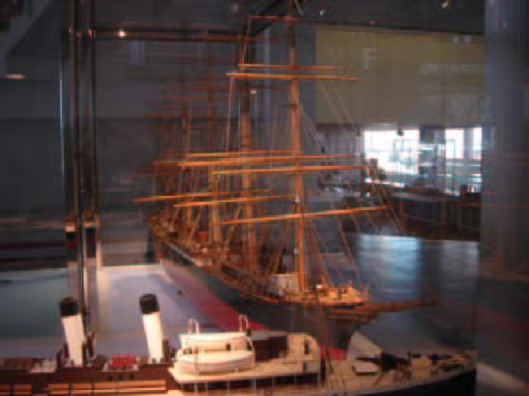 The picture at the left
shows some indication of the many other models at the museum, all of
which were very well done. Between this museum and the Tamm
collection, these last few days have been a real modeler’s delight.
After visiting the museum, we went “next door” to the replica
“Ubena” and went on a ride through the locks and out to the sea. It
was fun setting the huge sail. The whole group had a great time
aboard, but it was a good thing that this particular cog had an
engine, or we may still be on the way back! A jolly good dinner was
enjoyed in the evening. Next month, Amsterdam.
The picture at the left
shows some indication of the many other models at the museum, all of
which were very well done. Between this museum and the Tamm
collection, these last few days have been a real modeler’s delight.
After visiting the museum, we went “next door” to the replica
“Ubena” and went on a ride through the locks and out to the sea. It
was fun setting the huge sail. The whole group had a great time
aboard, but it was a good thing that this particular cog had an
engine, or we may still be on the way back! A jolly good dinner was
enjoyed in the evening. Next month, Amsterdam.
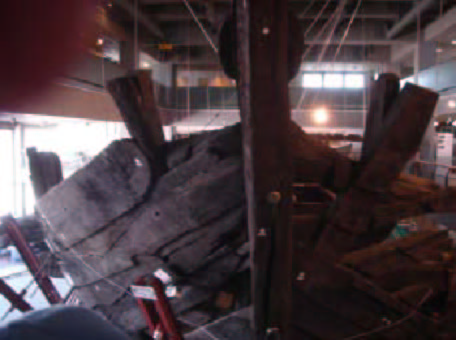

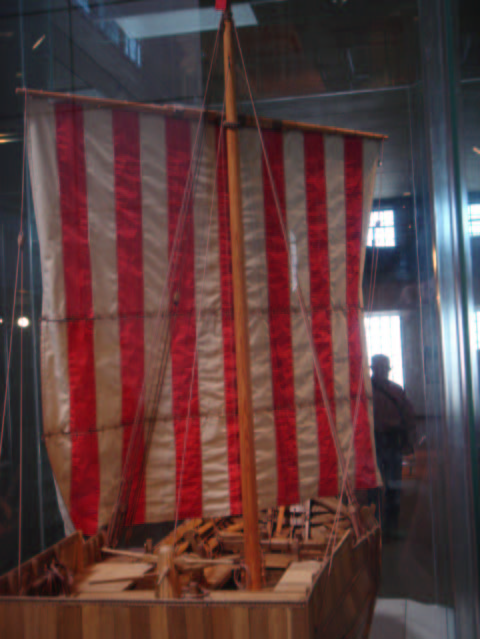
---To be continued
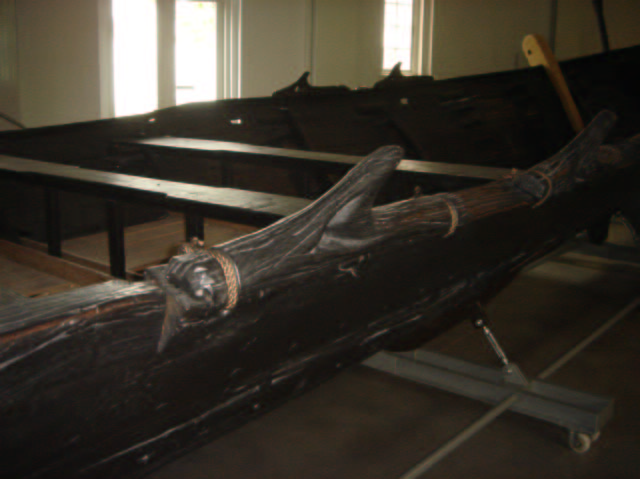
 contains two types of long ships used for warfare, knars or merchant
vessels used for long range trade, and coastwise vessels, providing
a cross section of Viking maritime life. Along with the five Viking
vessels, that are partially assembled, there are also very good
models of the vessels and, outside the museum, five replicas of the
real ships that you can actually sail on. This is really a very
large museum complex, and you could spend a full day here. There is
a film to see in the museum’s main building where the five Viking
ships are housed as well as the models. Outside is the “harbor”
which has a lot of ships and boats on display at full scale (real
ships) along with the five rebuilt Viking ships, all of which can be
taken to sea. There is a workshop with all the tools
contains two types of long ships used for warfare, knars or merchant
vessels used for long range trade, and coastwise vessels, providing
a cross section of Viking maritime life. Along with the five Viking
vessels, that are partially assembled, there are also very good
models of the vessels and, outside the museum, five replicas of the
real ships that you can actually sail on. This is really a very
large museum complex, and you could spend a full day here. There is
a film to see in the museum’s main building where the five Viking
ships are housed as well as the models. Outside is the “harbor”
which has a lot of ships and boats on display at full scale (real
ships) along with the five rebuilt Viking ships, all of which can be
taken to sea. There is a workshop with all the tools
 used by the Vikings to make their ships. When I say tools, I really
mean all the different kind of “axes” that were used – no saws,
hammers, etc. The evening was again spent in enjoying the
hospitality of the Danish people. My wife Liz was very taken with
the colors of the buildings in Copenhagen and the beautiful canals
that went throughout the city.
used by the Vikings to make their ships. When I say tools, I really
mean all the different kind of “axes” that were used – no saws,
hammers, etc. The evening was again spent in enjoying the
hospitality of the Danish people. My wife Liz was very taken with
the colors of the buildings in Copenhagen and the beautiful canals
that went throughout the city. After breakfast in Copenhagen, we departed via coach (a very nice
ride) for Schleswig, Germany. This was the ninth day of the trip, so
we were about half way through the excursion. The countryside that
you pass while traveling is very picturesque. While on these coach
trips, we were privileged to have comprehensive lectures on the
things we had seen and the things we were going to see by Dr.
Ashley, the Executive Director of the
After breakfast in Copenhagen, we departed via coach (a very nice
ride) for Schleswig, Germany. This was the ninth day of the trip, so
we were about half way through the excursion. The countryside that
you pass while traveling is very picturesque. While on these coach
trips, we were privileged to have comprehensive lectures on the
things we had seen and the things we were going to see by Dr.
Ashley, the Executive Director of the
 Maritime
Museum of San Diego. We found out later that he is also Captain
Ashley, but more about that when we get to England. In Schleswig we
went to the Schloss Gotorp Museum, which is really a German castle.
There, we saw the Nydam boat, c 310-320 AD, a rowing proto Viking
ship found in a bog on the Jutland Peninsula. This vessel is a
superbly crafted expression of early Dark Age naval power and
possibly exemplifies the kind of vessels that were used to conduct
migrations of Germanic peoples in the time of Beowolf and the
Anglo-Saxon invasions of Britain.
Maritime
Museum of San Diego. We found out later that he is also Captain
Ashley, but more about that when we get to England. In Schleswig we
went to the Schloss Gotorp Museum, which is really a German castle.
There, we saw the Nydam boat, c 310-320 AD, a rowing proto Viking
ship found in a bog on the Jutland Peninsula. This vessel is a
superbly crafted expression of early Dark Age naval power and
possibly exemplifies the kind of vessels that were used to conduct
migrations of Germanic peoples in the time of Beowolf and the
Anglo-Saxon invasions of Britain. The
Nydam boat was housed in it’s own building next to the castle. The
castle itself was a museum with many, many interesting items to see.
Then, behind the Nydam boat building was a carriage house, which had
a great many different carriages and sleds to see. Again, there was
a lot to see and not enough time available to see everything. The
grounds around the castle were also very beautiful, reminding me of
the Huntington Gardens in San Marino. After the night’s stay at the
Hotel Waldschlosschen (which, by the way, has no problems with
swimming – one person forgot his bathing suit but wanted to go
swimming in the hotel pool. The receptionist said that was no
problem, he/she could just swim in the nude – they have no problem
with that) we departed for Hamburg, Germany.
The
Nydam boat was housed in it’s own building next to the castle. The
castle itself was a museum with many, many interesting items to see.
Then, behind the Nydam boat building was a carriage house, which had
a great many different carriages and sleds to see. Again, there was
a lot to see and not enough time available to see everything. The
grounds around the castle were also very beautiful, reminding me of
the Huntington Gardens in San Marino. After the night’s stay at the
Hotel Waldschlosschen (which, by the way, has no problems with
swimming – one person forgot his bathing suit but wanted to go
swimming in the hotel pool. The receptionist said that was no
problem, he/she could just swim in the nude – they have no problem
with that) we departed for Hamburg, Germany.

 Hamburg
is a vibrant city with world-class shopping. Germany’s second
largest city, it has a magnificent harbor right at its center and
many canals and bridges. We were very lucky in that we got to visit
the Peter Tamm collection at the Institute fur Schiffahrt und
Marinegeschichte. This is currently a private collection that will
shortly (2009) become public at the Hamburg Maritime Museum. There
are over 5,000 paintings, watercolors and graphics from 1570 to
present, 2,000 big ship models, 22,000 smaller ship models, military
uniforms from the German
Hamburg
is a vibrant city with world-class shopping. Germany’s second
largest city, it has a magnificent harbor right at its center and
many canals and bridges. We were very lucky in that we got to visit
the Peter Tamm collection at the Institute fur Schiffahrt und
Marinegeschichte. This is currently a private collection that will
shortly (2009) become public at the Hamburg Maritime Museum. There
are over 5,000 paintings, watercolors and graphics from 1570 to
present, 2,000 big ship models, 22,000 smaller ship models, military
uniforms from the German
 Navy
as well as WWII uniforms from Britain, the US, France, etc. The
picture at the left shows the very large model of the Frederick
Wilhelm mounted from the roof and hanging between the stairs leading
to the third floor as seen from the lower landing . The picture at
the right shows one of the many paintings.
Navy
as well as WWII uniforms from Britain, the US, France, etc. The
picture at the left shows the very large model of the Frederick
Wilhelm mounted from the roof and hanging between the stairs leading
to the third floor as seen from the lower landing . The picture at
the right shows one of the many paintings.
 I managed to take these two pictures before we were told we could
not take pictures – was really sorry about that, as there were so
many models and things to take pictures of. OH, WELL – you can’t win
them all. There are two of the currently four existing in the world
ENIGMA machines (Germany’s secret coding machine during WWII),
plates, silverware, and other artifacts from ships, maps, globes,
etc. In short, the collection is awesome. We were lucky to see the
collection (they had a
I managed to take these two pictures before we were told we could
not take pictures – was really sorry about that, as there were so
many models and things to take pictures of. OH, WELL – you can’t win
them all. There are two of the currently four existing in the world
ENIGMA machines (Germany’s secret coding machine during WWII),
plates, silverware, and other artifacts from ships, maps, globes,
etc. In short, the collection is awesome. We were lucky to see the
collection (they had a
 great
model of what the WWII German aircraft carrier would have looked
like if built) all in one place.
great
model of what the WWII German aircraft carrier would have looked
like if built) all in one place. as
there was a lot to see. The Bremen Cog, c. 1380, is a medieval
merchant ship buried accidentally during a flood and recently found,
excavated intact, and replicated in fully working form. This Bremen
Cog is a superb example of the most important ship type of the
Middle Ages in the time of the Hansa League. Displacing and
superseding the much lighter Viking craft, the cog set the
technological stage for the advent of European sea borne empires a
century and a half later.
as
there was a lot to see. The Bremen Cog, c. 1380, is a medieval
merchant ship buried accidentally during a flood and recently found,
excavated intact, and replicated in fully working form. This Bremen
Cog is a superb example of the most important ship type of the
Middle Ages in the time of the Hansa League. Displacing and
superseding the much lighter Viking craft, the cog set the
technological stage for the advent of European sea borne empires a
century and a half later.
 The picture at the left
shows some indication of the many other models at the museum, all of
which were very well done. Between this museum and the Tamm
collection, these last few days have been a real modeler’s delight.
After visiting the museum, we went “next door” to the replica
“Ubena” and went on a ride through the locks and out to the sea. It
was fun setting the huge sail. The whole group had a great time
aboard, but it was a good thing that this particular cog had an
engine, or we may still be on the way back! A jolly good dinner was
enjoyed in the evening. Next month, Amsterdam.
The picture at the left
shows some indication of the many other models at the museum, all of
which were very well done. Between this museum and the Tamm
collection, these last few days have been a real modeler’s delight.
After visiting the museum, we went “next door” to the replica
“Ubena” and went on a ride through the locks and out to the sea. It
was fun setting the huge sail. The whole group had a great time
aboard, but it was a good thing that this particular cog had an
engine, or we may still be on the way back! A jolly good dinner was
enjoyed in the evening. Next month, Amsterdam.

